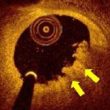This study sought to randomly compare the double-layer Roadsaver stent (Terumo) with the single-layer Carotid Wallstent device (Boston) in association with either distal filter-like embolic protection device FilterWire (Boston) or proximal protection device Mo.Ma (Medtronic) in patients with lipid-rich carotid plaques. This is a very interesting work because there are no head-to-head simultaneous comparisons between<a href="https://solaci.org/en/2020/05/04/the-whole-toolkit-tested-in-carotid-artery-stenting/" title="Read more" >...</a>
The Era of Provisional Stenting for Bifurcations Comes to an End
After the large studies which set provisional stenting as the preferred strategy to treat bifurcations comes the double kissing crush technique (DK crush) to break the mold once again. This time, the DK crush technique is tested against provisional stenting in the left main, with a 3-year follow-up. The DKCRUSH-V, soon to be published in<a href="https://solaci.org/en/2019/10/17/the-era-of-provisional-stenting-for-bifurcations-comes-to-an-end/" title="Read more" >...</a>
New Device for More Protection in Carotid Artery Stenting
This new “Paladin” system for post-dilation during carotid artery stenting was safe and may effectively reduce the number of particles that reach the brain, with a subsequent decreased risk for peri-procedural stroke. This study evaluated the safety and efficacy of the Paladin System, a novel post-dilation balloon with an integrated distal protection filter designed to<a href="https://solaci.org/en/2019/04/22/new-device-for-more-protection-in-carotid-artery-stenting/" title="Read more" >...</a>
Safety of Early Carotid Artery Stenting in Symptomatic Patients
This work shows the safety of carotid artery stenting within 14 days of a stroke and, so far, this is the largest series of symptomatic patients published by an institution. The exact moment to conduct this procedure after an acute stroke is still controversial, although most publications so far have favored early endarterectomy over early angioplasty.<a href="https://solaci.org/en/2018/10/12/safety-of-early-carotid-artery-stenting-in-symptomatic-patients/" title="Read more" >...</a>
TCT 2018 | OAC-ALONE: Anticoagulation Alone 1 Year After Stenting in Patients with Atrial Fibrillation
Up to now, there had been no randomized controlled trial assessing oral anticoagulation alone vs. oral anticoagulation plus antiplatelet therapy in patients with atrial fibrillation 1 year after stenting in a setting of stable coronary disease. Such was the vacuum that this work, presented at TCT 2018 and published simultaneously in Circulation, attempted to fill. This trial<a href="https://solaci.org/en/2018/10/08/tct-2018-oac-alone-anticoagulation-alone-1-year-after-stenting-in-patients-with-atrial-fibrillation/" title="Read more" >...</a>
Direct Stenting vs. Conventional Angioplasty and Their Interaction with Thrombus Aspiration
The rates of direct stenting are higher among patients randomized to thrombus aspiration. The rates of clinical events and myocardial reperfusion did not differ significantly between a direct stenting strategy vs. predilation and stenting, and no interaction was observed as regards thrombus aspiration. Several preliminary studies have emerged from the hypothesis that a direct stenting<a href="https://solaci.org/en/2018/09/17/direct-stenting-vs-conventional-angioplasty-and-their-interaction-with-thrombus-aspiration/" title="Read more" >...</a>
SOLACI-SOCIME 2018 | How to Choose Between Carotid Stenting and Carotid Endarterectomy for Stroke Prevention
Read articles on the main presentations of the first day of SOLACI-SOCIME 2018 Congress. See the presentation by Dr. Christopher White, entitled “ How to Choose Between Carotid Stenting and Carotid Endarterectomy for Stroke Prevention”. We are interested in your opinion. Please, leave your comments, thoughts, questions, etc., below. They will be most welcome.f
Post Carotid Stenting Cerebral Hyperperfusion: a Preventable Complication
This syndrome, which can be reverted, is also one of the causes of preventable stroke, at least in the context of carotid endarterectomy. At present, there is little information on the incidence of this condition in the context of carotid stenting, which is the purpose of this study, in addition to providing tips to prevent it.<a href="https://solaci.org/en/2018/07/23/post-carotid-stenting-cerebral-hyperperfusion-a-preventable-complication/" title="Read more" >...</a>
Antithrombotics after Venous Stenting: Rather Different from Coronary Artery Stenting
Should the Antithrombotic/antiplatelet therapy following 10.0 by 60 mm stent implantation to the subclavian vein of a chronic kidney patient be the same as one following a 3.0 by 18 mm stent implantation to the second segment of the left anterior descending artery of this same patient? The daily practice of many interventional cardiologists performing<a href="https://solaci.org/en/2018/05/24/antithrombotics-after-venous-stenting-rather-different-from-coronary-artery-stenting/" title="Read more" >...</a>
OCT Follow-Up of Plaque Erosion with Medical Therapy and Without Stenting
Most acute coronary syndromes (ACS) are caused by the following three different pathologies: Plaque rupture Plaque erosion Calcified nodule In daily clinical practice, all patients who experience them are treated with angioplasty, regardless of which of these physiopathologies led to the ACS in each case. Some early reports indicate that patients with plaque erosion might<a href="https://solaci.org/en/2018/01/25/oct-follow-up-of-plaque-erosion-with-medical-therapy-and-without-stenting/" title="Read more" >...</a>









